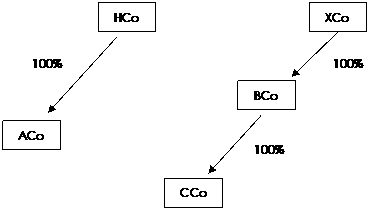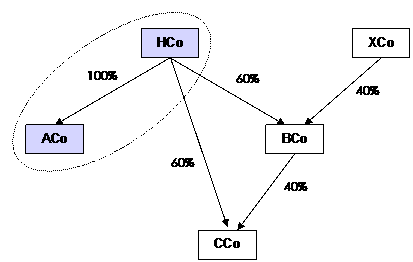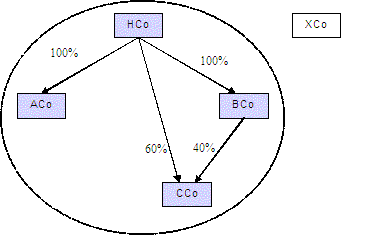Consolidation Reference Manual
You can still refer to the Consolidation reference manual for consolidation information that has not been impacted by changes in the legislation.
C2 Assets
C2-2 High-level worked example
Cost setting on entry
C2-2-130 Linked entities join a consolidated group
Description
This high-level example shows how the cost setting rules apply when entities linked by ownership become subsidiary members of an existing consolidated group at the same time. The cost setting process is similar to that on formation. → 'Treatment of assets', C2-1
Commentary
When linked entities join a consolidated group, the basic case cost setting rules are modified in a similar way as in the formation of a consolidated group → Subdivision 705-D, Income Tax Assessment Act 1997 (ITAA 1997). The modifications illustrated in this case study include:
- •
- top-down application of cost setting rules
- •
- adjustment to entry ACA step 4, and
- •
- adjustment to market value of an asset reflecting certain membership interests, for the purpose of allocating the ACA to reset cost base assets.
Example
Facts
On 1 July 2001, XCo capitalises BCo with $200 and BCo capitalises CCo with $200. The only asset in BCo is shares in CCo. The assets in CCo are $100 Cash, as well as Land purchased by CCo on that date for $100.
Figure 1: HCo and other entities

During the year ending 30 June 2002, CCo makes an after tax profit of $100 and distributes a fully franked dividend of $100 to BCo on 30 June 2002.
| Cash asset | $100 | Equity | $200 |
| Shares in CCo | $200 | Profit (after tax) | $100 |
| $300 | $300 |
| Cash asset | $100 | Equity | $200 |
| Land | $100 | $200 | |
| $200 | |||
| Note: the fully franked dividend of $100 has been paid out to BCo. | |||
| Cash asset | $400 | Equity | $500 |
| Shares in ACo | $100 | ||
| $500 | $500 |
On 1 July 2002, HCo forms a consolidated group with ACo. At that time, HCo purchases, from BCo, 60 of the 100 ordinary shares in CCo for $120 (market value of $2 per share). On the same day, HCo purchases, from XCo, 60 of the 100 ordinary shares in BCo for $180 (market value of $3 per share).
Figure 2: HCo consolidated group and other entities

On 2 July 2002, BCo distributes its dividend income of $100 (from CCo) to HCo and XCo ($100 for 100 shares = $1 per share). In line with ownership, HCo receives a fully franked dividend of $60 ($1 per share x 60 shares) and XCo receives $40.
| Cash asset | $120 | Equity | $200 |
| Shares in CCo | $80 | Retained Profit | $0 |
| $200 | $200 | ||
| Note: Cash asset of $120 is the receipt from sale of 60 shares in CCo to HCo. Under the equity method of accounting, BCo's asset reflecting shares in CCo is reduced by $120 to $80. | |||
| Cash asset | $100 | Equity | $200 |
| Land | $100 | ||
| $200 | $200 |
| Cash asset | $160 | Equity | $500 |
| Shares in ACo | $100 | Profit | $60 |
| Shares in BCo | $120 | Loss | ($60) |
| Shares in CCo | $120 | ||
| $500 | $500 | ||
| Note: The Cash asset of $160 includes the $60 fully franked dividend received from BCo. Under the equity method of accounting, HCo's asset reflecting shares in BCo is reduced by $60 to $120. | |||
On 30 June 2003, BCo purchases a machine priced at $40.
For year ended 30 June 2003, CCo makes a trading loss (also tax loss) of $100. Because HCo directly owns 60% of shares in CCo and indirectly owns 24% of shares in CCo (60% ownership of BCo multiplied by BCo's 40% ownership of CCo), $84 of the loss was accrued to the HCo consolidated group.
| Cash asset | $80 | Equity | $200 |
| Shares in CCo | $40 | Loss | ($40) |
| Machine | $40 | ||
| $160 | $160 | ||
| Note: Under the equity method of accounting, BCo's asset reflecting shares in CCo is reduced by $40 to $40 to account for CCo's loss. | |||
| Cash asset | $0 | Equity | $200 |
| Land | $100 | Loss | ($100) |
| $100 | $100 |
| Cash asset | $160 | Equity | $500 |
| Shares in ACo | $100 | Loss | ($60) |
| Shares in BCo | $120 | ||
| Shares in CCo | $60 | ||
| $440 | $440 | ||
| Note: Under the equity method of accounting, HCo's asset reflecting shares in CCo is reduced by $60 to $60 to account for CCo's loss. | |||
On 1 July 2003, HCo purchases 40 shares in BCo for $64 (market value of $1.60 per share x 40 shares) from XCo. Now BCo is 100% owned by HCo and joins HCo's consolidated group on that date. CCo is now also wholly owned by HCo because of HCo's purchase of shares in BCo, and joins the consolidated group at the same time.
Figure 3: HCo consolidated group

| Cash asset | $80 | Equity | $200 |
| Shares in CCo | $40 | Loss | ($40) |
| Machine | $40 | ||
| $160 | $160 | ||
| Note: Under the equity method of accounting, BCo's asset reflecting shares in CCo is reduced by $40 to $40 to account for CCo's loss. | |||
| Cash asset | $0 | Equity | $200 |
| Land | $100 | Loss | ($100) |
| $100 | $100 |
| Cash asset | $96 | Equity | $500 |
| Shares in ACo | $100 | Loss | ($60) |
| Shares in BCo | $184 | ||
| Shares in CCo | $60 | ||
| $440 | $440 |
Timeline
| 1.7.01 | XCo capitalises BCo and CCo. |
| 30.6.02 | CCo distributes $100 fully franked dividend to BCo. |
| 1.7.02 | HCo forms a consolidated group. |
| HCo acquires 60% of CCo and 60% of BCo. | |
| 2.7.02 | BCo successively distributes $100 to XCo and HCo. |
| 30.6.03 | CCo makes tax loss of $100 for income year ending 30.6.03. |
| 1.7.03 | HCo purchases 40% of BCo from XCo. |
| BCo and CCo join HCo consolidated group. |
Calculation - setting tax costs of BCo's assets
Calculate entry ACA for BCo
ACA step 1: Add up the cost of each membership interest
On 1 July 2002, HCo acquires 60 shares in BCo for $3.00 per share. On 1 July 2003, HCo acquires the remaining 40 shares in BCo for $1.60 each. The market value of shares in BCo at the joining time is $1.60 each. → table 10
For the first 60 shares, the step 1 amount for each share is its reduced cost base ($3.00) because the market value is less than the reduced cost base at the joining time. For the next 40 shares, the step 1 amount for each share is its cost base ($1.60) because the market value is equal to the cost base. Assume no adjustment is required to the cost base or reduced cost base. → section 705-65, ITAA 1997
The step 1 amount is: ($3.00 x 60) + ($1.60 x 40) = $244.
ACA steps 2, 3 and 3A
These steps are not applicable in this example because BCo has no liability, undistributed profit or rollovers at the joining time.
ACA step 4
BCo distributes a fully franked dividend of $60 to HCo on 2 July 2002. The profit from which the dividend is paid did not accrue to the HCo consolidated group but instead reflects a return of capital. The amount is subtracted here at step 4 because it is a distribution directly to the head company. → section 705-230, ITAA 1997
The result of step 4 is $244 - $60 = $184
ACA steps 5 and 6
These steps are not applicable in this example because BCo has no tax losses. Therefore, the result after step 6 is $184.
ACA step 7
This step is not applicable as there are no inherited deductions.
ACA step 8
The ACA is $184.
Allocating the ACA to BCo's assets (cost setting process steps B to D)
BCo has a Cash asset of $80 at the joining time, which as a retained cost base asset has a tax cost setting amount of $80. After subtracting $80 from the ACA, the remainder ($104) is allocated to the reset cost base assets according to their market values. → table 13
| Assets | Market value | Apportionment | Allocated value |
|---|---|---|---|
| Machine | $40.00 | 40. 00 / 114 x $104.00 = | $36 |
| Shares in CCo | $74 | 74 / 114 x $104.00 = | $68 |
| Total | $114 | $104.00 | $104.00 |
| Note: The market value of Shares in CCo is increased by BCo's interest in the loss adjustment amount for CCo. BCo's interest in the loss adjustment amount is worked out by dividing the market value of BCo's shares in CCo ($40) by the market value of all shares in CCo ($100), and then multiplying the result by the amount to be included in CCo's ACA calculation under step 5 ($84). The result - i.e. ($40/$100) x $84 = $33.60 - is added to the $40 market value of BCo's shares in CCo = $73.60 (rounded to $74). → section 705-235, ITAA 1997 | |||
The cost setting amount for a revenue-like asset cannot exceed the greater of its terminating value or market value. Therefore the tax cost setting amount for the Machine cannot exceed $40 → section 705-40, ITAA 1997. As the tax cost setting amount is less than $40 there is no reduction required at step C. Accordingly there is no consequent excess to reallocate to the remaining reset cost base assets (i.e. the Shares in CCo).
No adjustment is required at step D as BCo has no over-depreciated asset. The tax cost setting amounts for the assets in BCo are $36 for the Machine and $68 for the Shares in CCo.
Calculation - setting tax costs of CCo's assets
Calculate entry ACA for CCo
ACA step 1: Add up the cost of each membership interest
For the 60 shares directly owned by HCo, the step 1 amount is the sum of their reduced cost bases ($2.00 per share x 60 shares = $120.00), because the market value at the joining time ($1.00 per share) is less than the reduced cost base ($2.00 each). → table 11
For the 40 shares owned by BCo, the step 1 amount is the tax cost setting amount just worked out for BCo's asset that reflects shares in CCo ($68).
Therefore, the step 1 amount is $188 ($120 + $68).
ACA steps 2, 3 and 3A
These steps are not applicable in this example because CCo has no liability or undistributed profit or rollovers at the joining time.
ACA step 4
CCo distributes a fully franked dividend of $100 to BCo on 30 June 2002. BCo successively distributes $60 of the dividend income to HCo on 2 July 2002. The profit from which the dividend is paid did not accrue to the HCo consolidated group but instead reflects a return of capital.
However, this amount was paid out of the amount to be deducted under entry ACA step 4 for BCo (BCo made a direct distribution to HCo). The $60 is not reduced under this step for CCo. → section 705-230, ITAA 1997
ACA step 5
CCo has a tax loss of $100. Of this, $84 accrued to HCo because HCo directly and indirectly held 84% - i.e. 60% + (60% x 40%) - of shares in CCo when CCo incurred the loss. Therefore, the step 5 amount is $84.
The result after step 5 is $104 ($188 - $84).
ACA step 6
Assume the tax loss of $100 is transferable to HCo at the joining time. Of this loss, $16 ($100 - $84) did not accrue to the group. Therefore, the step 6 amount is $5 ($16 x 30% company tax rate, rounded to the nearest dollar).
The result after step 6 is $99 ($104 - $5).
ACA step 7
This step is not applicable as there are no inherited deductions.
ACA step 8
The ACA is $99.
Allocating the ACA to CCo's assets
CCo has only one asset, Land, which is a reset cost base asset. Therefore, the tax cost setting amount for Land is $99.
References
Income Tax Assessment Act 1997 , section 705-65 ; as amended by:
- •
- New Business Tax System (Consolidation) Act (No. 1) 2002 (No. 68 of 2002), Schedule 1
- •
- New Business Tax System (Consolidation, Value Shifting, Demergers and Other Measures) Act 2002 (No. 90 of 2002), Schedule 2
- •
- New Business Tax System (Consolidation and Other Measures) Act (No. 1) 2002 (No. 117 of 2002), Schedules 3 and 5
Income Tax Assessment Act 1997 , Subdivision 705-D , sections 705-210 to 705-235 ; as amended by New Business Tax System (Consolidation and Other Measures) Act (No. 1) 2002 (No. 117 of 2002), Schedule 4 , and New Business Tax System (Consolidation and Other Measures) Act 2003 (No. 16 of 2003), Schedule 1
Explanatory Memorandum to the New Business Tax System (Consolidation and Other Measures) Bill (No. 1) 2002, paragraphs 1.30-1.42
Explanatory Memorandum to New Business Tax System (Consolidation and other measures) Bill (No. 2) 2002, paragraphs 5.53-5.60
Current at 28 May 2003
